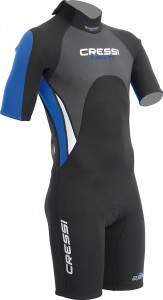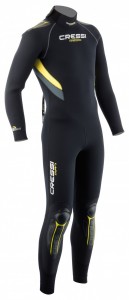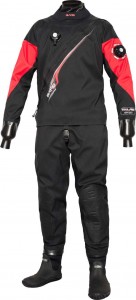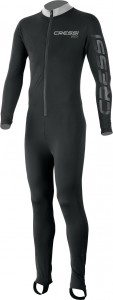Protecting Yourself from Exposure: The Where and Why of Dive Suits
They may not be your Sunday best, but the suits we wear as divers can make or break the fun of a scuba adventure. There are plenty of options and situations which require the use of a wet or dry suit, so for this article we will review the different ways to protect yourself in the water, and out of the water.
Pieces of the Wetsuit Pie
Before we get too deep into preparing you for your next dive party, let’s start with an overview of your dive party ensemble. The first and most obvious piece is the body suit. A one or two piece suit that comes in different coverage classes.
The one piece full body suit covers the diver from neck to ankles, and all the way down to the wrists. The one piece is the most common type of suit you see divers wearing. They offer substantial thermal protection while diving in temperate and cold water, and when properly fitted have minimal water transfer. Minimizing water transfer in and out of a suit is vital to keep your body warm in all water types. These full suits will range in thicknesses as thin as 0.5 mm to thicker than 7mm.

The other common type of suit is the “shorty”. Basically a T-Shirt and shorts combined together and made out of neoprene. Shorties are great suits for warm water, and are much easier to put on than a full suit.
Choosing what type of suit to wear depends on a few important factors.
First: You need to determine where you will be getting wet.
Colder water means you will need a thicker suit. The beautiful kelp forests of the California and Washington coasts call for at least a 7mm suit to experience the rush of flying through a canopied forest among sea lions, giant black sea bass, and whales.
The warmer, more tropical waters of the Caribbean call for thinner suit, around 1-3mm. While a thicker suit is usable, having too thick of a suit can cause a diver to get too hot in the water. Have you ever tried sweating 60 feet underwater? It’s a strange sensation.
Second: What kind of constitution do you have?
If you are like me you can get away with wearing a 3-5 mm suit in 55F degree water. I love the cold, and my body keeps me nice and toasty, so a 7mm is often too hot and uncomfortable for me. Most people aren’t quite so cold inclined as I am, so as a diver you need to understand how well you weather different temperatures. If you are a person who wears a sweater in low 70 degree weather, you may want to consider a thicker suit.
Third: How much diving will you be doing?
One of the wonderful properties of water is how it absorbs heat, and works to bring objects to an equilibrium of temperature. What does this have to do with diving? The more time you spend in water the lower your body temperature will become. If you are a multi-day multi-dive adventurer then even in the warmest waters of the South Pacific you can start to get chilly. However, using a 3mm suit will help keep the chill off, and will keep you diving comfortably.

If you plan to visit the colder parts of the magnificent underwater world, I would recommend trying a drysuit out. As discussed a moment ago, your body temperature lowers while in the water. If you aren’t getting wet then your temperature doesn’t drop. A drysuit prevents the water from zapping away your heat, leaving you with more energy for more diving.

Drysuits come in two types; nylon shell and neoprene. Each has their advantages and disadvantages. The nylon shell doesn’t offer thermal protection to the diver, but it is more versatile in different water temperatures. Like you would layer your clothes on a regular day at home, you can layer your clothing (yeah clothing, like when James Bond walked out of the ocean and was immediately in his tux) to suit how cold the water is.
Neoprene suits keep a diver warmer, and can be used in the most extreme reaches of cold water. They too can be layered to increase the toasty feeling.
A little extra wetsuit advice:
Regardless of where you are diving, consider using a suit or combination of suits that will cover your entire body. When diving in tropical waters we are tempted to think that we don’t need to be fully covered, but you will still want to make sure your body is protected from other elements not related to water temperature. The first, and worst, is the sun. Nothing will put a stop to admiring sea turtles and nurse sharks off the shores of the Virgin Islands than a nasty sunburn. Sure you can wear sunscreen to help protect you, but sunscreen wears off, and the chemicals can bleach and damage fragile coral reefs. Putting a dive skin underneath your shorty will block out the sun, help protect our wonderful marine playground, and protect you from our next reason; physical contact.

Have you ever been so focused on the mesmerizing colors of a school or angel fish that you drifted along into a rocky outcrop or a colony of corals? Layering yourself with a diveskin, or a full wetsuit, will protect you from the bumps and scrapes that can happen from time to time, even to the most aware and conscientious diver. Think of a dive skin like putting on a pair of gloves before cleaning the bathroom.
So, regardless of where or when you will be diving make sure you pack your diving best. If you are a wanderer of the wilds like me you may need to pick up a couple suits (I have four) so you can be prepared to get wet wherever you find a puddle. From lakes and rivers to the vast expanse of the oceans, preparing the proper suit will make all the difference.
This is me all dolled up and ready to enter that water in Monterey Bay, California. I am wearing a 3mm full wetsuit. My dive computer recorded a steamy 57 degree water temperature. Dive was great, lots of crabs out patrolling the old cannery pipes that day.

 CAD
CAD
